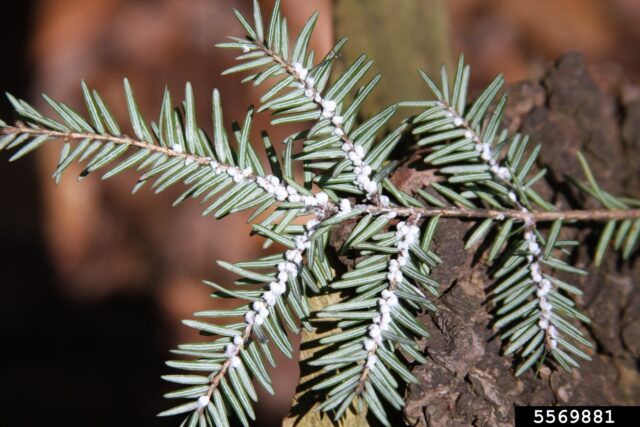 Winter is the best time to look for evidence of an infestation. Cooler temperatures trigger feeding activity, and as the hemlock woolly adelgids feed, they secrete a white, waxy material that creates ovisacs. The presence of these small, round, white masses makes it possible to identify infested trees. As they feed, these tiny, soft-bodied insects consume a hemlock’s stored nutrients, slowly sucking the life from the tree.
Winter is the best time to look for evidence of an infestation. Cooler temperatures trigger feeding activity, and as the hemlock woolly adelgids feed, they secrete a white, waxy material that creates ovisacs. The presence of these small, round, white masses makes it possible to identify infested trees. As they feed, these tiny, soft-bodied insects consume a hemlock’s stored nutrients, slowly sucking the life from the tree.
The eastern hemlock (Tsuga canadensis) is one of the most important tree species in our region. These trees cast the most shade of any native tree species, and a hemlock canopy creates unique environments that many other species such as brook trout rely on. Hemlocks also tend to grow on the cliffs of many of the gorges around the Finger Lakes. If we lose hemlocks, it becomes increasingly likely that these cliffsides will collapse and alter many of our waterways. By protecting hemlocks, not only are trees themselves protected, but also the organisms that rely on them for habitat.
The Finger Lakes PRISM is launching its annual Hemlock Woolly Adelgid (HWA) Survey and they are looking for clubs and individuals to help them out. The 2022 was a pilot year for the HWA Survey and it was a great success. Across 12 events PRISM trained and recruited 181 people to scour for HWA across our region and recorded over 80 observations. For 2023, they would like to build upon the progress!
What is the FL-PRISM HWA Survey?
FL-PRISM created the survey to find new populations of HWA in the region and help prioritize control measures where hemlocks can still be saved. They train volunteers on what hemlock woolly adelgids are why they are a threat. Once trained they are lead them on a guided hike to find HWA. If left unchecked, HWA threatens to wipe out the eastern hemlock, one of our most important native tree species.
What would working with the HWA Survey look like?
The process for the HWA survey is simple. Your organization will set up a date with the Finger Lakes PRISM where they will deliver a presentation (can be over zoom, in the field, or at an event space) and then lead volunteers to search for HWA on local hemlock trees. The entire process usually runs about 2 hours. They are open for scheduling training events with partners on weekdays or weekends from January 4th to the end of April (with the exception of 2/16-2/19 and 3/10-3/20).
If interested Contact Matt Gallo gallo@hws.edu to set up a workshop session, share advertisements about the HWAS on social media
Signup for the survey here: https://forms.gle/NYfU5yYe67f5KjF57 (opens new tab)

